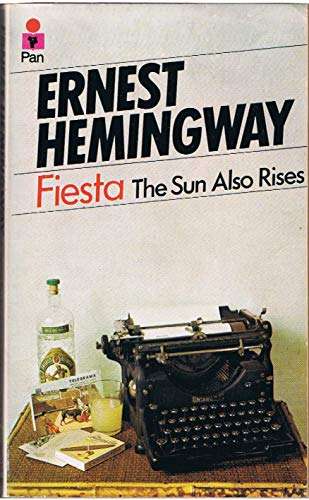
Fiesta, the Sun Also Rises by Ernest Hemingway
Check my rate
| Main centres: | 1-3 business days |
| Regional areas: | 3-4 business days |
| Remote areas: | 3-5 business days |

| Main centres: | 1-3 business days |
| Regional areas: | 3-4 business days |
| Remote areas: | 3-5 business days |
Pan Books, 1973, softcover, 206 pages, condition: very good.
The Sun Also Rises first appeared in 1926, and yet it's as fresh and clean and fine as it ever was, maybe finer. Hemingway's famously plain declarative sentences linger in the mind like poetry: "Brett was damned good-looking. She wore a slipover jersey sweater and a tweed skirt, and her hair was brushed back like a boy's. She started all that." His cast of thirtysomething dissolute expatriates--Brett and her drunken fiancé, Mike Campbell, the unhappy Princeton Jewish boxer Robert Cohn, the sardonic novelist Bill Gorton--are as familiar as the "cool crowd" we all once knew. No wonder this quintessential lost-generation novel has inspired several generations of imitators, in style as well as lifestyle.
Jake Barnes, Hemingway's narrator with a mysterious war wound that has left him sexually incapable, is the heart and soul of the book. Brett, the beautiful, doomed English woman he adores, provides the glamour of natural chic and sexual unattainability. Alcohol and post-World War I anomie fuel the plot: weary of drinking and dancing in Paris cafés, the expatriate gang decamps for the Spanish town of Pamplona for the "wonderful nightmare" of a week-long fiesta. Brett, with fiancé and ex-lover Cohn in tow, breaks hearts all around until she falls, briefly, for the handsome teenage bullfighter Pedro Romero. "My God! he's a lovely boy," she tells Jake. "And how I would love to see him get into those clothes. He must use a shoe-horn." Whereupon the party disbands.
But what's most shocking about the book is its lean, adjective-free style. The Sun Also Rises is Hemingway's masterpiece--one of them, anyway--and no matter how many times you've read it or how you feel about the manners and morals of the characters, you won't be able to resist its spell. This is a classic that really does live up to its reputation.
Ernest Miller Hemingway was an American novelist, short-story writer and journalist. Best known for an economical, understated style that significantly influenced later 20th-century writers, he is often romanticized for his adventurous lifestyle, and outspoken and blunt public image. Most of Hemingway's works were published between the mid-1920s and mid-1950s, including seven novels, six short-story collections and two non-fiction works. His writings have become classics of American literature; he was awarded the 1954 Nobel Prize in Literature, while three of his novels, four short-story collections and three nonfiction works were published posthumously.
Hemingway was raised in Oak Park, Illinois. After high school, he spent six months as a cub reporter for The Kansas City Star before enlisting in the Red Cross. He served as an ambulance driver on the Italian Front in World War I and was seriously wounded in 1918. His wartime experiences formed the basis for his 1929 novel A Farewell to Arms. He married Hadley Richardson in 1921, the first of four wives. They moved to Paris where he worked as a foreign correspondent for the Toronto Star and fell under the influence of the modernist writers and artists of the 1920s' "Lost Generation" expatriate community. His debut novel The Sun Also Rises was published in 1926.
He divorced Richardson in 1927 and married Pauline Pfeiffer. They divorced after he returned from the Spanish Civil War, where he had worked as a journalist and which formed the basis for his 1940 novel For Whom the Bell Tolls. became his third wife in 1940. He and Gellhorn separated after he met in London during World War II. Hemingway was present with Allied troops as a journalist at the Normandy landings and the liberation of Paris. He maintained permanent residences in Key West, Florida, in the 1930s and in Cuba in the 1940s and 1950s. On a 1954 trip to Africa, he was seriously injured in two plane accidents on successive days, leaving him in pain and ill health for much of the rest of his life. In 1959, he bought a house in Ketchum, Idaho, where, in mid-1961, he died of suicide.